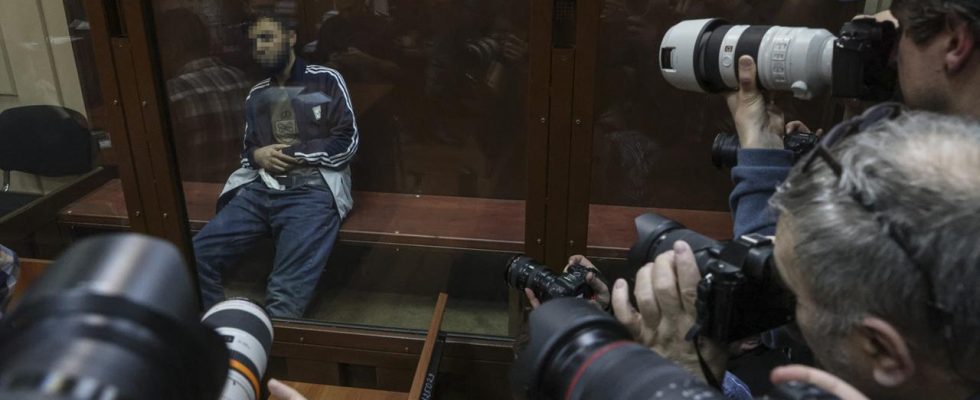The circumstances under which the suspected perpetrators of the attack near Moscow were arrested continue to raise questions. What is clear, however, is that they were severely mistreated. Apparently everyone should see this.
Russia’s security forces have never had a reputation for being squeamish when dealing with suspects. But the images of the four men who are said to have been involved in the terrorist attacks on the Crocus concert hall near Moscow were unusual even by Russian standards.
Four men were brought before Moscow’s Basmanny District Court on Sunday evening who had clearly been severely mistreated. A man whose name was given as Saidakrami Murodali Ratschabalisoda not only had bruises on his head and a swollen eye.
Saidakrami Murodali Ratschabalisoda sits in the booth at the Basmanny District Court in Moscow with an injury to his ear.
He wore a bandage over his left ear – apparently part of his ear had been cut off after his arrest. According to media reports, a video showing the brutal process was distributed via a Telegram channel close to the Wagner Group.
Torture with electric shocks?
Another detainee, Shamsidin Fariduni, also appeared in court with significant facial swelling. Pictures on Telegram are also said to show how he was tortured with electric shocks in the genital area after his capture.
Dalerdzhon Mirsoyev also has bruises on his face.
A plastic bag hung around the neck of the arrested man, Dalerdzhon Mirsoyev, in court – observers concluded that this had deprived him of the air he could breathe. He also had a black eye.
The fourth defendant, whose name was given as Muhammadsobir Fajsov, was wheeled into the courtroom on a wheelchair in hospital scrubs. Observers wrote that he lost consciousness during the hearing. Apparently he is missing his left eye.
Muhammadsobir Fajsov sits in court in hospital clothes.
The Russian security forces made no effort to conceal or cover up the suspects’ condition in court – rather, the impression was that the public in the country and internationally needed to see how the men were treated.
Allegations with a history
The fact that Russia’s security organs mistreat suspects is not a new allegation: the non-governmental organization Human Rights Watch (HRW) has long been leveling it against the country’s authorities. The Russian non-governmental organization Crew Against Torture lists more than 3,700 cases of human rights violations and more than 370 cases of torture on its website.
The “clearly demonstrative character of torture” represents a new quality, the London “Guardian” quotes Tanya Lokshina from HRW. Apparently the images of the suspects were not spread unintentionally, but as a targeted warning to everyone who was planning attacks in Russia:
Such videos show the extent to which violence has been normalized in Russia over the past two years of war. Previously, there were widespread allegations of systematic torture by Russian security authorities. But until now it would have been unthinkable that they would have proudly published video evidence.
The Russian political scientist and journalist Kirill Rogov goes even further and recognizes in the events a special technique used by Russian President Vladimir Putin to react to crises and exposed weaknesses. The “Dekoder” portal quotes Rogow as follows:
The technique is this: When a crisis exposes your weakness, the fury of retaliation must be unleashed on whoever is within reach. This is usually not the person responsible for your weakness. But that doesn’t matter. Above all, the violence and effectiveness of the blow should eliminate the impression of your weakness that was created by the defeat you previously suffered. That is the purpose of this technology.
Medals and death penalty?
According to media reports, some of the officers who were involved in apprehending the suspects have already received awards. At the same time, the Russian government said it was unimpressed by the torture allegations and declined to comment.
Ex-President Dmitry Medvedev spoke out in favor of this and demanded that everyone who was involved in the attack or even sympathized with the perpetrators should be killed.
Now, at least since Russia’s attack on Ukraine, Medvedev has been filling the role of the uninhibited agitator. And yet he is not alone in that a debate about reintroducing the death penalty broke out in Russia after the terrorist attack. This was repealed in 1999 by then President Boris Yeltsin.
Parliamentary leader Vyacheslav Volodin now took the view that the death penalty could be quickly reintroduced because it had never been formally abolished. All that is required is a decision from the Constitutional Court. In such decisions, the value of confessions extracted under torture does not seem to matter.

